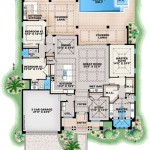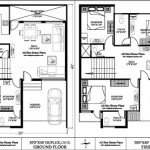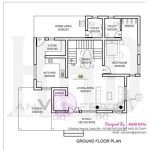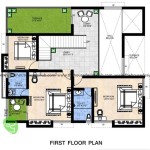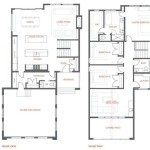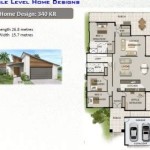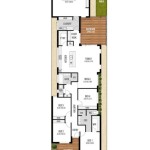Bi-Level RTM House Plans: A Comprehensive Guide
Bi-level RTM (Ready-to-Move) homes offer a unique blend of architectural design and practical living space. Characterized by a split-level entryway leading to either an upper or lower level, these homes maximize square footage and provide distinct living zones. This article explores the key features, advantages, and considerations associated with bi-level RTM house plans.
One of the primary appeals of bi-level RTM homes lies in their efficient use of space. The staggered floor plan allows for a more compact footprint, making them well-suited for smaller lots or properties with unique topographical features. This design also creates a natural separation between public and private areas, enhancing family life and providing a sense of privacy.
Typically, the main entry level of a bi-level RTM home opens to a landing area with stairs leading both up and down. The upper level commonly houses the main living areas, such as the kitchen, dining room, and living room. This arrangement takes advantage of natural light and often provides access to balconies or decks, extending the living space outdoors.
The lower level of a bi-level RTM home usually contains bedrooms, bathrooms, and additional living spaces like a family room or recreation area. This separation provides a quieter, more private zone for sleeping and relaxation, away from the activity of the main living areas. Some bi-level designs also incorporate a walk-out basement on the lower level, providing direct access to the backyard and enhancing the connection with the outdoors.
Bi-level RTM homes present several advantages over traditional single-story or two-story homes. The compact design often translates to lower construction costs and reduced energy consumption. The separation of living spaces provides greater privacy and noise reduction, benefiting families with varying schedules or lifestyles. The split-entry design can also improve accessibility for individuals with mobility limitations, as fewer stairs are required to reach either the main living area or the bedrooms.
The distinct architectural style of bi-level homes offers curb appeal and can be customized to suit individual preferences. Exterior finishes, roofing materials, and landscaping can be tailored to complement the surrounding environment and create a visually appealing home. The interior layout can also be customized to accommodate specific needs, such as adding additional bedrooms, expanding the kitchen, or incorporating a home office.
When considering bi-level RTM house plans, several factors warrant careful consideration. The lot size and topography are crucial elements, as the split-level design is best suited for sloped or uneven terrains. The orientation of the home on the lot should be optimized to maximize natural light and minimize energy consumption.
The number of bedrooms and bathrooms required should be carefully evaluated based on the needs of the occupants. The size and layout of the kitchen, dining area, and living room should also be considered to ensure they meet the family's lifestyle and entertaining needs. Storage space is another critical factor, and bi-level designs often incorporate built-in closets, pantries, and other storage solutions to maximize functionality.
Accessibility features, such as wider doorways, grab bars, and ramps, can be incorporated into the design to accommodate individuals with mobility limitations. Energy efficiency measures, such as high-performance windows, insulation, and energy-efficient appliances, can be included to reduce energy consumption and lower utility costs.
The selection of an experienced and reputable RTM builder is paramount to ensuring the quality and structural integrity of the home. It is essential to thoroughly research potential builders, review their portfolio of completed projects, and verify their licensing and insurance credentials. A clear and comprehensive contract should be established, outlining the scope of work, payment schedules, and warranty provisions.
Customization options should be discussed with the builder to ensure the home meets the specific needs and preferences of the occupants. Changes to the floor plan, exterior finishes, and interior fixtures can often be accommodated during the construction process. Regular communication with the builder throughout the project is essential to ensure the project stays on schedule and within budget.
Transporting and setting the RTM home on the prepared foundation requires careful planning and coordination. The route from the builder's facility to the building site must be assessed to ensure adequate clearance for the oversized load. Cranes or other heavy equipment may be required to lift and position the home onto the foundation. Utility connections, such as electricity, water, and sewer, must be coordinated with local utility companies to ensure a smooth transition.
Once the RTM home is set on the foundation, final finishing work, including connecting utilities, completing interior trim, and landscaping, is typically handled by local contractors. Inspections by local building authorities are required to ensure the home meets building codes and safety regulations. A final walkthrough with the builder is conducted to identify any remaining deficiencies and ensure all aspects of the project are completed to the homeowner's satisfaction.
Bi-level RTM homes offer a compelling combination of efficient design, flexible living spaces, and cost-effectiveness. By carefully considering the factors outlined above, individuals seeking a unique and practical housing solution can make informed decisions and embark on a successful RTM home building journey.

Quick Possession Rtm Homes Nelson

Modular House Plans Nelson Homes

Rtm Floor Plans Warman Homes

Star Diy Rtm Home Packages

Innovative Ready To Move Prefab Homes Nelson

Ready To Move Rtm Homes Cottages Zak S Building Group

Modular House Plans Nelson Homes

Country House Plans New Tiny Floor

Innovative Ready To Move Prefab Homes Nelson

Innovative Ready To Move Prefab Homes Nelson

